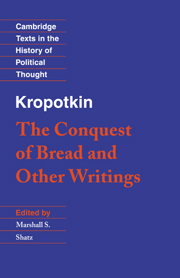Book contents
- Frontmatter
- Contents
- Introduction
- Principal events in Kropotkin's life
- Bibliographical note
- Biographical synopses
- The Conquest of Bread
- Preface
- Our riches
- Well-being for all
- Anarchist communism
- Expropriation
- Food
- Dwellings
- Clothing
- Ways and means
- The need for luxury
- Agreeable work
- Free agreement
- Objections
- The collectivist wages system
- Consumption and production
- The division of labour
- The decentralization of industry
- Agriculture
- Other writings
- Index
- Cambridge Texts in the History of Political Thought
Consumption and production
Published online by Cambridge University Press: 05 June 2012
- Frontmatter
- Contents
- Introduction
- Principal events in Kropotkin's life
- Bibliographical note
- Biographical synopses
- The Conquest of Bread
- Preface
- Our riches
- Well-being for all
- Anarchist communism
- Expropriation
- Food
- Dwellings
- Clothing
- Ways and means
- The need for luxury
- Agreeable work
- Free agreement
- Objections
- The collectivist wages system
- Consumption and production
- The division of labour
- The decentralization of industry
- Agriculture
- Other writings
- Index
- Cambridge Texts in the History of Political Thought
Summary
Looking at society and its political organization from a different standpoint than that of all the authoritarian schools – for we start from a free individual to reach a free society, instead of beginning by the state to come down to the individual – we follow the same method in economic questions. We study the needs of the individuals, and the means by which they satisfy them, before discussing production, exchange, taxation, government, and so on.
At first sight the difference may appear trifling, but in reality it upsets all the canons of official political economy.
If you open the works of any economist you will find that he begins with production, i.e., by the analysis of the means employed nowadays for the creation of wealth: division of labour, the factory, its machinery, the accumulation of capital. From Adam Smith to Marx, all have proceeded along these lines. Only in the latter parts of their books do they treat of consumption, that is to say, of the means resorted to in our present society to satisfy the needs of the individuals; and even there they confine themselves to explaining how riches are divided among those who vie with one another for their possession.
Perhaps you will say this is logical. Before satisfying needs you must create the wherewithal to satisfy them. But, before producing anything, must you not feel the need of it?
- Type
- Chapter
- Information
- Kropotkin: 'The Conquest of Bread' and Other Writings , pp. 158 - 164Publisher: Cambridge University PressPrint publication year: 1995



